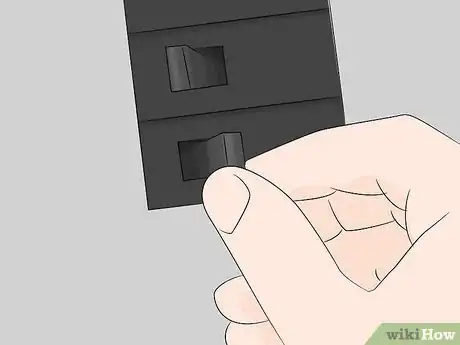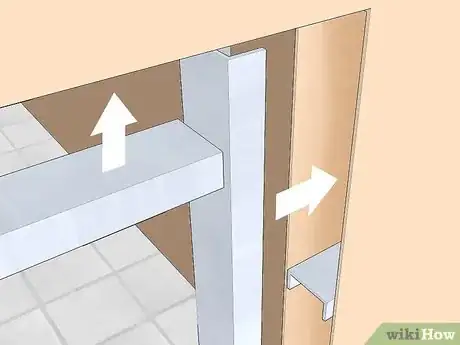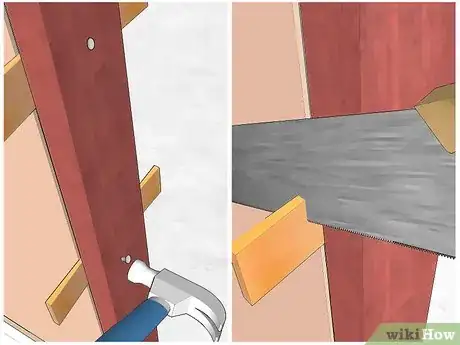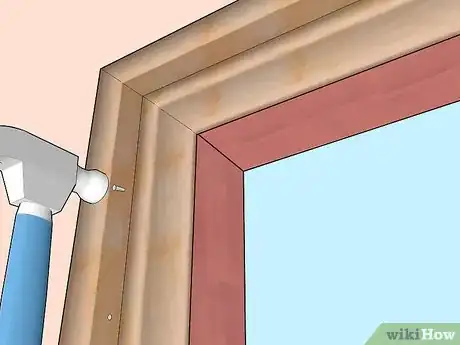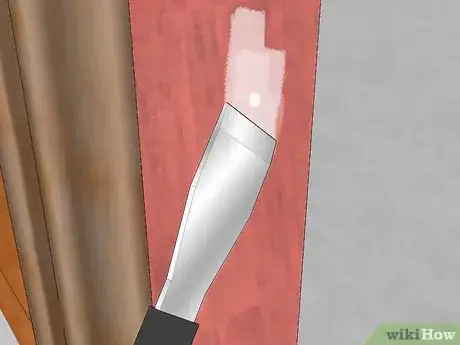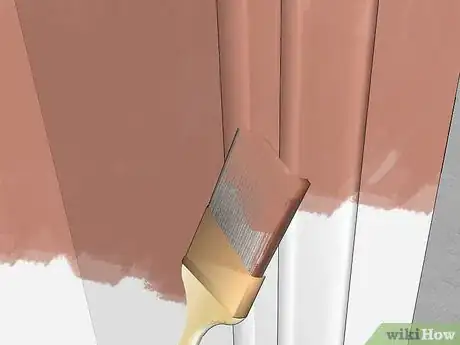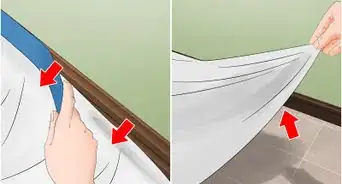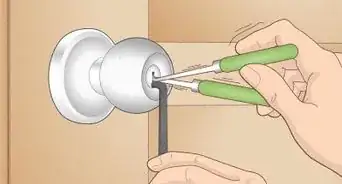X
wikiHow is a “wiki,” similar to Wikipedia, which means that many of our articles are co-written by multiple authors. To create this article, volunteer authors worked to edit and improve it over time.
This article has been viewed 122,219 times.
Learn more...
There are many reasons for needing to widen a doorway. A wider doorway can let in light and give the room a more open feel, or better accommodate someone in a wheelchair. With the following instructions, you can widen a doorway yourself in a few hours.
Steps
-
1Measure and draw an outline for the widened doorway on the wall.[1] If you are widening the doorway for wheelchair access, the width of the doorway should be a minimum of 40 inches (101.6 cm), but 4 feet (1.2 m) is better, if possible.
-
2Pry off the casing as well as any baseboard and chair rail that falls within the area you will be cutting to widen the doorway.[2]
- Insert a chisel or pry bar beneath the outer edges of the jamb or trim.
- Place a shim between the tool and wall to prevent marring of the drywall.
- Push down on the tool’s handle to pry the casing or trim away from the wall.
Advertisement -
3Inspect behind the wall before cutting.
- Pick a small block of wood as a template. Place it against the wall near where you will be cutting to widen the doorway and trace around it with a pencil.
- Cut along the traced lines with a rotary cutting tool. Wear eye protection while using any cutting tool.
- Take out the drywall piece and insert a small mirror. Look for electrical wires, pipes or other things that you might need to avoid while cutting.
-
4Turn off the power for the area in which you will be working.[3]
-
5Cut along the lines you drew for the widened doorway with a rotary cutting tool.[4]
-
6Pull the framing from the existing doorway.
- Cut through the nails that secure the doorjamb to the rest of the framing with a reciprocating saw.
- Cut through the nails at the foot of the studs.
- Pull the studs from the existing doorway.
- Use a Japanese saw to cut the baseboard from the floor. Be careful not to mar the floor.
- Pry the baseboard from the floor using the same technique as you did on the door casing and trim.
-
7Frame the new doorway.[5]
- Cut 2-by-4-inch boards for the new doorway. Remember to make the top stud short enough to fit between the longer vertical studs.
- Secure the new stud in place by driving in wood screws at an angle, or nailing them.
- Install the new header. Insert shorter studs, or cripple studs, between the header and the top of the framing. Secure them in place with screws.
-
8Secure drywall to the studs with drywall screws.[6]
-
9Install a new doorjamb.
- Place new doorjamb on the top of the doorway.
- Stand the new side pieces in place. Slip in shims behind it and nail the side jambs in place.
- Cut off the ends of the shims that extend beyond the doorway with a saw.
-
10Nail the new casing around the doorway with finish nails.
- Cut the ends of the casing at a 45-degree angle with a miter saw in the upper corners.
-
11Finish the drywall.
- Apply joint compound to the joints with a putty knife.
- Cut and press paper joint tape into the joint compound. Apply a second coat of joint compound on top of it.
- Sand the joint compound after it dries.
-
12Replace the baseboard or trim you removed.
-
13Fill any holes in the wood with wood putty.
-
14Prime and paint the trim and walls in the color you choose.
Advertisement
Community Q&A
-
QuestionHow do I find load bearing walls, are they usual in bathroom doorways?
 Community AnswerCould very well be. Commonly, bathrooms are stacked for plumbing purposes and a tiled bath weighs an awful lot, not to mention a water filled tub. Or, joists may run perpendicular to the door's wall and actually join or overlap over that door and wall. It just depends on actual structure design, there are all sorts and you can never just assume.
Community AnswerCould very well be. Commonly, bathrooms are stacked for plumbing purposes and a tiled bath weighs an awful lot, not to mention a water filled tub. Or, joists may run perpendicular to the door's wall and actually join or overlap over that door and wall. It just depends on actual structure design, there are all sorts and you can never just assume.
Advertisement
Things You'll Need
- Yardstick
- Pencil
- Chisel
- Pry bar
- Shims
- Small wooden block
- Mirror
- Safety glasses
- Rotary cutting tool
- Reciprocating saw
- Japanese handsaw
- 2-by-4-inch lumber for framing
- Hand saw
- Wood screws
- Drywall
- Drywall screws
- Drill and drill bits
- Wood for doorjamb
- Door casing
- Miter saw
- Finish nails
- Hammer
- Joint compound
- Wide putty knife
- Drywall tape
- Sandpaper
- Wood putty
- Primer
- Paint
References
- ↑ https://www.youtube.com/watch?v=r_tX79jtcaQ
- ↑ https://www.youtube.com/watch?v=r_tX79jtcaQ
- ↑ https://www.ronhazelton.com/projects/widen-your-doorway-through-these-few-easy-steps
- ↑ https://www.thisoldhouse.com/ask-toh/widening-door-opening
- ↑ https://www.hometalk.com/39892619/widen-and-expand-doorway?expand_all_questions=1
- ↑ https://www.ronhazelton.com/projects/widen-your-doorway-through-these-few-easy-steps
About This Article
Advertisement



